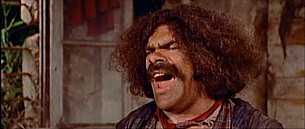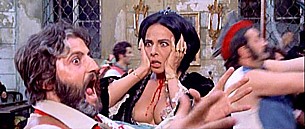The Five Days/Review
From The Grindhouse Cinema Database
< The Five Days

Rarely seen outside of Italy Dario Argento’s ‘The Five Days’ (Le Cinque Giornate) occupies a unique position in the director’s body of work and as such is rarely written about. It was a significant departure for the director following his first three thrillers; an eccentric period set satire. If one is kind enough to ignore 2009’s unintentionally hilarious ‘Giallo’ it is the director’s only comedy.
The year is 1848. Incarcerated crook Cainazzo escapes from prison when a cannonball fortuitously blows a hole in his cell wall only to find himself surrounded by the chaos of revolution; the citizens of Milan in violent conflict with occupying Austrian forces (and each other). The thief sets off in search of his friend Zampino, a previous partner-in-crime who has since become a renowned freedom-fighter nick-named ‘Liberty’, but is persistently diverted from his odyssey by bizarre episodic digressions, the interference of eccentric characters and outbursts of political violence. He befriends a dim-witted young baker called Romolo whose bakery is destroyed by another errant cannonball. The two men stumble from one comic catastrophe to the next frequently conscripted into one or other of the fighting factions.
Socially marginalised by virtue of his criminal occupation Cainazzo is a classic example of the fool who, through accidents of misfortune and misadventure, ultimately gains wisdom and insight into all the false values of society. His outcast status is a trait shared with many dysfunctional Argento protagonists. Priests, soldiers, aristocrats and revolutionaries are all revealed to be pursuing the same agenda; fighting for power and wealth, or promoting a strange, intangible variation of freedom that some of them call ‘democracy’. In contrast, and to their detriment, Cainazzo & Romolo offer help to those in need without their actions serving a political agenda even if this extends to giving an enema to a pregnant lady!
In one scene a fight breaks out over a wounded man’s death bed when several parties disagree on what his final whispered words were; a priest hears him exalt the Pope, a patriot hears him damn the Austrians, and a peasant revolutionary insists he called for the bourgeoisie to be hung. When Cainazzo is asked if he heard what the dying man said he replies; “Of course I heard. He said: ‘Fuck off, all of you!’”
The political satire, although heavy handed, is well aimed but instances of slapstick and farce irritate more than they amuse (although the latter may have proved more popular with an Italian audience). The film maintains a Monty Python-esque level of exuberant violence and hysteria and is populated with gleefully barmy characters such as the Countess who becomes sexually aroused when her bosom is splashed with blood during a battle. And look out for ‘The Beast in Heat’ himself Salvatore Baccaro (aka Sal Boris) in a small role!
Adopting a more serious tone, the film’s final scenes achieve a level of emotion which is conspicuously absent from all of Argento’s subsequent movies; a preoccupation with style and technique has resulted in the director’s other films often lacking in persuasive performances and emotional depth yet here he deftly conveys melancholy, pathos, injustice and loss. At a key moment Cainazzo insists that he is not crying, it’s just smoke making his eyes water.
Certain stylistic elements which feature recurrently in Argento’s horror movies do appear here; the maestro’s touch is apparent in the tracking shots which prowl around scenes, gliding into the very centre of the filmic action (the pursuit of the Countess, by Argento’s subjective lens, through the rooms of her rundown abode is one particularly striking moment that wouldn’t have appeared out of place in the director’s much maligned adaptation of ‘Phantom of the Opera’), and also in the striking use of primary colours, particularly those appearing on flags but also scattered throughout interiors via bright skeins of wool and jars full of peculiar pickles, which punctuate the otherwise weathered and dusty palette of the war torn locations.
I can’t whole-heartedly recommend the film to fans of Argento’s other work simply because it departs so drastically from the director’s most popular narrative preoccupations; for a non-Italian audience it is therefore essentially an item of curiosity rather than some lost masterpiece. And at almost 2 hours in length its episodic narrative does try the patience at times. However when viewed alongside such recent embarrassments as the astonishingly idiotic, and technically sloppy, ‘Mother of Tears’(2007), ‘The Five Days’ displays a considerable amount of the energy and eccentricity so admired by Dario devotees.
Narcan is the GCDb's esteemed UK contributor. As a youth his earliest exploitation film experience was a My Bloody Valentine/The Funhouse midnight double bill. Grindhouse icons that he holds in highest regards are Christina Lindberg and Frank Henelotter. Two of his favorite exploitation genres include Nunsploitation and Lucha Libre.



























